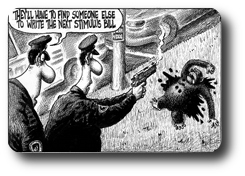Thursday 22 October, 7.00pm until 9.00pm, Kowalsky Gallery, London
 Venue: DACS, Kowalsky Gallery, 33 Great Sutton Street, London, EC1V 0DX
Venue: DACS, Kowalsky Gallery, 33 Great Sutton Street, London, EC1V 0DX
Tickets: £7.50 (£5 concessions) per person. Tickets are available from the Academy of Ideas website.
In one of Charles Schultz’s Peanuts strips, Lucy declares that she is going to be a political cartoonist ‘lashing out with my crayon’. From Gillray to Giles, Hogarth to Herblock, the most vicious political cartoons are often the most successful – capturing and caricaturing the urgency of political situations through the personal foibles of politicians. Gordon Brown in the past year has been variously depicted as a wheelchair bound incontinent and a sweating poker player betting it all on the joker (Peter Mandelson). But the best cartoonists’ work is insightful even when it’s cruel. As Theodore Dalrymple puts it ‘Gillray, like Swift before him and Dickens after him, saw everything through a lens that clarified even as it distorted’.
But we live in an era in which anything that can be seen as ‘offensive’ is met with all round disapproval. A storm erupted earlier this year after the New York Post published a cartoon showing police shooting a chimp, which was mistaken for a racist reference to President Obama. The New Yorker ‘Terrorist Fist-Jab’ cover featuring Obama and his wife Michelle had already caused a commotion, though the intention was actually to satirise fear-mongering. Any hint that a minority group is being targeted provokes calls for censorship. Martin Rowson’s depiction for the New Humanist of new atheists ‘outing’ themselves behind an effeminate Richard Dawkins brought accusations of homophobia. The cartoon series Popetown, was dropped by the BBC after protests by Roman Catholics. And we are all familiar with the controversy about cartoons depicting the prophet Mohammed.
Should political cartoonists pull no punches, whatever offence they cause? Does crude, physical caricaturing come with the territory when you are a public figure? Or is it too easy to lampoon politicians rather than their politics? Do we want cartoonists who are prepared to take risks and push at the boundaries of taste in order to make clearer the world we live in? If we curtail political cartooning in any way, are we effectively censoring the press or simply ensuring good taste? Where should we draw the line with political cartoons and offence?
 | Sarnath Banerjee artist, film-maker; graphic novelist, Corridor and Barn Owl's Wondrous Capers; founder, New Delhi's Phantomville comics publishing house |
 | Dave Brown political cartoonist, The Independent; author, Rogues’ Gallery: more misused masterpieces |
 | John Kampfner chief executive, Index on Censorship; former editor, New Statesman; author, Freedom For Sale: how we made money and lost our liberty |
 | Brendan O'Neill editor, spiked; columnist, Big Issue; contributor, Spectator; author, A Duty to Offend: Selected Essays |
 | Martin Rowson political cartoonist; illustrator; writer; author, Giving Offence |
| Chair: | |

|
Dr Shirley Dent
communications specialist (currently working with the British Veterinary Association media team); editor, tlfw.co.uk; author, Radical Blake |
Yale has acted cravenly over images of Muhammad.
Oliver Kamm, The Times, 29 September 2009
 Why is it that so many people around the world appear willing to give up freedoms in return for either security or prosperity? For the past 60 years it had been assumed that capitalism was intertwined with liberal democracy, that the two not just thrived together but needed each other to survive. But what happens when both are undermined?
Why is it that so many people around the world appear willing to give up freedoms in return for either security or prosperity? For the past 60 years it had been assumed that capitalism was intertwined with liberal democracy, that the two not just thrived together but needed each other to survive. But what happens when both are undermined?
John Kampfner, Simon & Schuster, 3 September 2009
Two dozen authorities, including diplomats and experts on Islam and counterterrorism, unanimously recommended that the book, “The Cartoons That Shook the World,” should not include the 12 Danish drawings that originally appeared in September 2005. What’s more, they suggested that the Yale press also refrain from publishing any other illustrations of the prophet that were to be included,
Patricia Cohen, New York Times, 12 August 2009Images of the poster of President Obama as the Joker have dominated the blogosphere, and Washington Post Culture Critic Philip Kennicott looks at how there is little consensus on whether it is effective as political messagemaking.
Philip Kennicott, Washington Post, 6 August 2009'Sometimes a cartoon is just a cartoon', the New York Post wrote in an editorial apologising for the offence caused by an image of policemen shooting a chimpanzee dead.
Stephen Mulvey and Ali McConnell, BBC News, 20 February 2009
 Tolerated in Britain for over 300 years-and ubiquitous throughout the world for much longer - visual satire gives offence in the quickest way and in its purest form. Cartoons have long since established themselves as a legitimate part of the general political discourse.
Tolerated in Britain for over 300 years-and ubiquitous throughout the world for much longer - visual satire gives offence in the quickest way and in its purest form. Cartoons have long since established themselves as a legitimate part of the general political discourse.
Martin Rowson, Seagull, 1 January 2009
I know this isn't all about me, but the row about those Danish cartoons of the Prophet Mohammed has made my life a misery.
Martin Rowson, New Humanist, 2 March 2006 Those cartoons: a caricatured argument
Those cartoons: a caricatured argument
All of this heat about the Danish cartoons is shedding no light on the important questions of free speech, genuine tolerance, multiculturalism and society today
Mick Hume, spiked, 6 February 2006